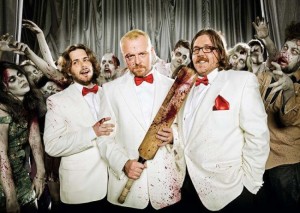There’s a reason why people invented stereotypes.
Humans are hardwired to recognize patterns. When we observe repetition of the same, or similar, occurrence over time, we recognize it as a pattern. Our neuron bundles are impartial to the details behind the pattern; our brains simply take it at face value.
A stereotype is born when one group of people sees another group of people behaving in a different way, repetitively, over time. Thus, the brain sees the pattern. If one attempts to rationalize or disprove the pattern, we enter the realm of philosophy.
Of course while clinging to stereotypes offers a chance to form personally validating relationships with others – namely, by making fun of the people you’re stereotyping together – they can be a destructive force. Often, the most baseless spreading of misinformation about a particular group has stereotyping at its root.
Artworks are subject to stereotypes just like people are, although since artworks aren’t living beings, we give it a different label: genre. Genres and sub-genres are our way of lumping together works of art that have superficial similarities. In the case of film, genre is arguably one of the worst categorizing systems ever implemented.
More often than I’d like to acknowledge, I’ve had the unfortunate experience of discussing an upcoming film with a friend or relative, only to hear them say something along the lines of “Oh, it’s a (slapstick comedy/historical drama/science fiction) film, right? I don’t think I’d like that.” Inevitably, no amount of plot summarizing or touting of top rate actors can convince them to get past the genre of the film. Thus, they never choose to watch it.
As I related in an earlier post, I was a slave to artistic stereotyping myself for many years. Luckily, I’ve since had the joy of maintaining an open mind. It’s incredible what having an open mind can do to one’s taste in entertainment. Like adding new or unusual spices to a familiar casserole, watching a movie you think you’re not going to enjoy can not only expand your horizons, but enrich your life in unexpected ways.
A great example of a genre-bending movie is Shaun of the Dead (Edgar Wright and Simon Pegg, 2004). While in Hollywood the horror/comedy mesh gained some popularity with films like Little Shop of Horrors (Howard Ashman, 1986), Edgar Wright certainly pulls it off beautifully. Horror is one of the ‘touchiest’ genres in American film, harboring a rather clear-cut fanbase and avoided altogether by many. However Wright builds up a multi-thread plotline in not just two but three genres: romance (win back the ex-girlfriend), comedy (both witty and slapstick), and of course horror (the main premise is a zombie apocalypse).
The main protagonist Shaun (Simon Pegg) is a classic underdog, with not only his personal life problems plaguing him, but an entire town of undead after his brains. Oblivious to the sudden appearance of a zombie populous around him for a good part of the beginning, Shaun ultimately redeems himself by the end, as he should. It’s incredibly hard to not enjoy this film, even when the blood splatters really start to fly.
There’s a shared desire amongst industry pros and moviegoers to see more of these hard to categorize films come into production. In the meantime, highly creative writers and directors will be busy doing their best to end the “Green Eggs & Ham” mentality when it comes to film.
